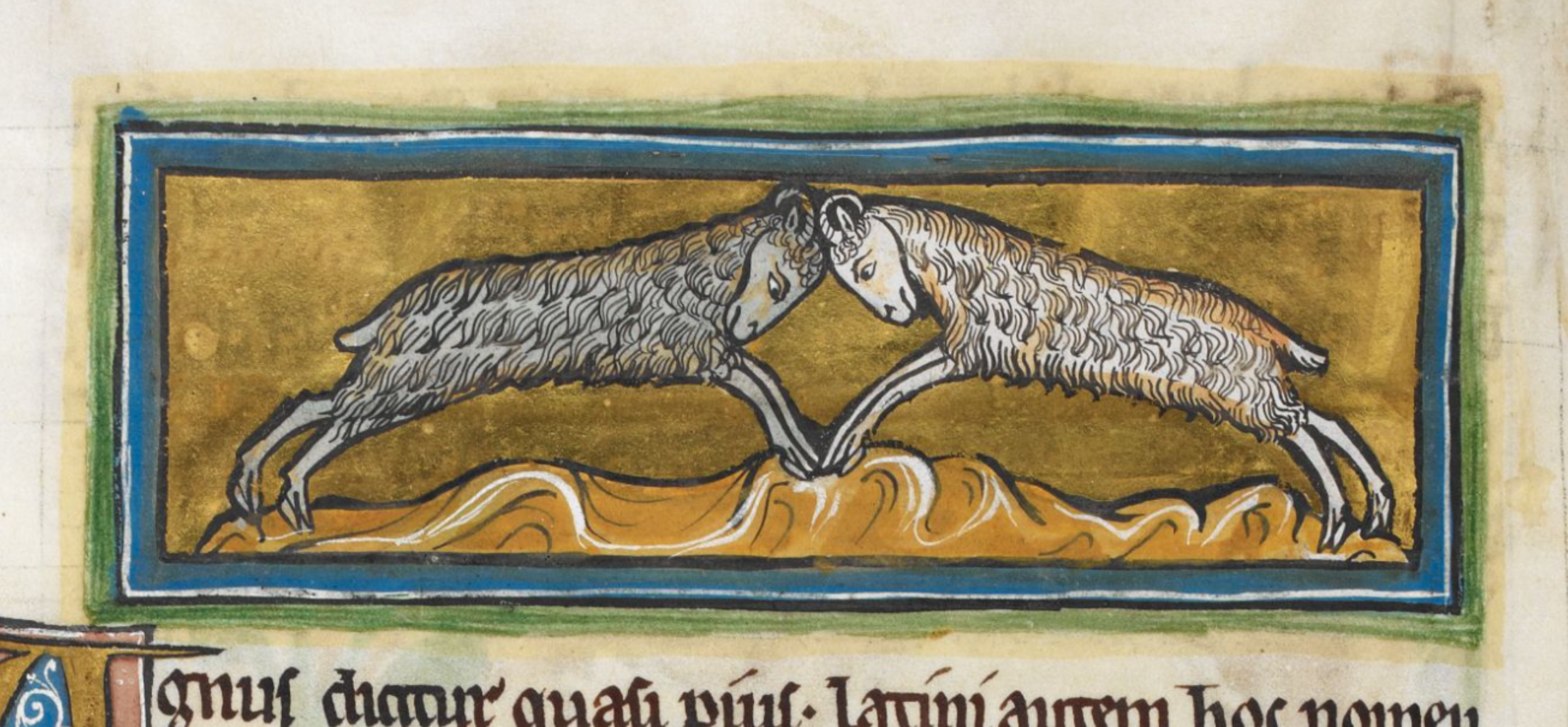
Ram, Rochester Bestiary, c.1230
Search page
Search within this page here, search the collection page or search the website.
Index
Sheep, Rochester Bestiary, c.1230
Boar, Rochester Bestiary, c.1230
Ram, Rochester Bestiary, c.1230
The ram is known particularly because of its role in the story of Abraham's willingness to sacrifice his son Isaac, where it was provided as a substitute offering. This narrative, found in the Book of Genesis NKJV 22:13: “Then Abraham lifted his eyes and looked, and there behind him was a ram caught in a thicket by its horns. So Abraham went and took the ram, and offered it up for a burnt offering instead of his son” in the Bible, symbolizes obedience to God and the concept of substitutionary sacrifice.
In Christian symbolism, the ram was sometimes seen as a precursor to Christ: just as the ram was offered as a substitute sacrifice in place of Isaac, Christians saw Jesus Christ as the ultimate substitute sacrifice for humanity's sins.

The ram's prominent horns symbolised leadership and strength, reflecting attributes often associated with kingship and authority and its watchful nature and habit of protecting the flock were seen as symbols of faithfulness and vigilance in guarding against spiritual dangers.
Another reference to the ram can be found in Daniel 8:3-8: “Then I lifted my eyes and looked, and behold, a ram which had two horns was standing in front of the canal. Now the two horns were long, but one was longer than the other, with the longer one coming up last. I saw the ram butting westward, northward, and southward, and no other beasts could stand before him nor was there anyone to rescue from his power, but he did as he pleased and magnified himself” where the ram with two horns symbolises the kingdom of Media and Persia.
F35r
or. vel quod sit vir id est masculus. vel quod vermes in
capite habeat. quarum excitati pruritu; invicem se con-
cutiunt. et pugnantes cum magno impetu. se invicem
feriunt. Aries vel atotoapfoc. idest a marte vocatus
Unde apud nos in gregibus masculi mares dicuntur si-
ve quod hoc pecus a gentilibus primo est aris inmolatum.
Unde est illud Aries mactatur ad aram.
A ram is called vervex from its strength, both for it is stronger than the other sheep, and for it is of male sex, or for it has worms in its head. When these are stimulated by itching, they shake mutually and, fighting with great force, strike each other. A ram is also called ărĭēs which is also the name of the God Mars, in Greek Ἄρης/Ares1. Hence, among us, in herds, males are called mares, for this type of animal was at first sacrificed on the altars, area, by the pagans. Hence, that ram2 was slaughtered on the altar.
Bibliography
David Badke, The Bestiary Blog: Animals in the Middle Ages, Ram, November 6 2023, https://bestiary.ca/beasts/beast194.htm
Josh Goldenberg (BA 2012) and Matt Shanahan (BA 2014), Logeion, November 2022, https://logeion.uchicago.edu/
Castiglioni, L. and Mariotti, S. (1996). Vocabolario della Lingua Latina: Latino-Italiano Italiano-Latino. Terza Edizione. Loescher Torino
Matthews, J. and Matthews C., (2010), The Element Encyclopedia of Magical Creatures, HarperCollins UK, London
Curley, M. J., Physiologus: A Medieval Book of Nature Lore (University of Chicago edition 2009)
Rackham, H., M.A., Pliny Natural History Volume III, Libri VIII-XI (London: William Heinemann Ltd, 1949)
Collins, A. H., M.A., Symbolism of Animals and Birds (New York: McBride, Nast & Company, 1913)
Henderson, C., The Book of Barely Imagined Beings (London: University of Chicago Press, 2013)
White, T. H., The Bestiary: A Book of Beasts (New York: G.P Putnam’s Sons, 1960)
Barney, S. A., Lewis, W. J., Beach A., Berghof O., The Etymologies of Isidore of Seville (New York: Cambridge University Press, 2006)
Footnotes
1 In Roman religion, there were some rituals called suovetaurilia maiora, apotropaic rituals designed to avert evil influences. Usually, a boar, a ram and a bull wee sacrificed to the God Mars. https://en.wikipedia.org/wiki/Suovetaurilia
2 It might be referring to the ram that Adam sacrificed to God.
